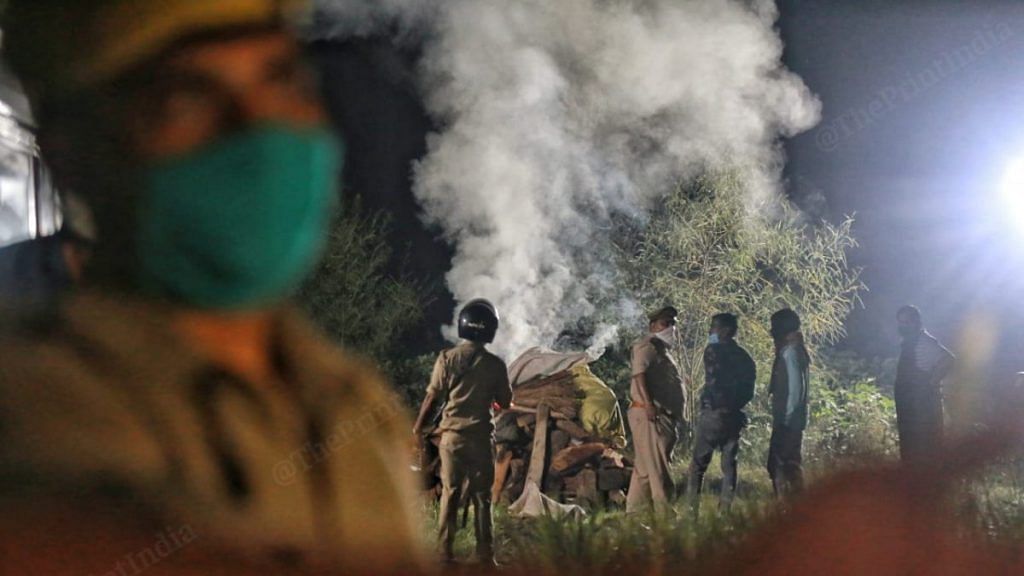The horrific cremation of the Hathras Dalit woman by the Uttar Pradesh Police in the dead of the night after locking up her family is a blatant effort to silence the case — not very different from what the alleged rapists did to her by strangulating her. Chief Minister Yogi Adityanath’s Uttar Pradesh is seeing a re-emergence of toxic power play, one in which the police acts as a feudal force with brazen impunity. And a poor Dalit woman is the weakest link in this power hierarchy. This cocktail of upper caste masculinity, the brute force of the police, and many regressive reactions to the crime is working to reverse decades of social justice struggles.
Every system of injustice gains its legs from the silent privileged supporters. Here too, it’s the privileged ‘upper caste’ who ultimately help create grounds for caste-based atrocities. They either actively come out in support of the perpetrators because of caste alliance or they are reluctant to identify the caste identity of the perpetrators, both of which were witnessed in the Hathras case.
This nexus invariably seeks to invisibilise the privilege that the ‘upper castes’ enjoy in India. And it acts more aggressively when the power structure is challenged — which is what the modern-day Bahujans are seeking to do. Whether it’s the vocal Dalits on social media or parties like Chandrashekhar Azad’s Bhim Army, the challenge to the Brahminical structure of India’s caste-ridden society is more visible and loud now. This unnerves the beneficiaries of the hierarchical structure.
While the Hathras gangrape and murder is not an isolated incident, the Adityanath government and the UP Police’s response to it does speak of the culmination of a long-standing resentment against calls for social justice.
Also read: Hathras Dalit woman, who was gang-raped and assaulted, dies at Safdarjung Hospital
Rape is assertion of power
Former Supreme Court judge Markandey Katju said in a Facebook post that rape incidents like Hathras happen because young men in India are unemployed and unmarried — putting it down to their “natural urge” to indulge in sex.
Similarly, many people on Twitter were against pointing out that the 20-year-old woman in Hathras was a Dalit. ‘Rape is rape, why bring caste into it,’ goes their argument.
What you really meant, @_pallavighosh was "As an upper caste woman, all that matters to you is that her caste should be made irrelevant for your narrative to hold. So you will not think beyond it because, why make the effort to change things that benefit you? Say it properly. https://t.co/D7ct3gqALg
— Divya Malhari (@Datlitwriter) September 29, 2020
Rape is neither about sexual urges nor about what the woman was doing or wearing. It is always about power, domination and control. And in the Indian context, it translates into caste.
According to the National Crime Records Bureau (NCRB), four Dalit women are raped every day in India. And in most cases, there is no conviction. In the Hathras case, the UP Police didn’t even register the FIR for 10 hours. To ignore caste or vilify those who speak about it, is a product of discomfort that comes from any challenge to the privileges enjoyed under the caste-based hierarchical structure of the Indian society.
Also read: There can be no modern India without an improved police force — think tank urges for reforms
‘Ram rajya’, an upper caste fantasy
Despite being a constitutional democracy with an elected government, there is constant talk of bringing in ‘Ram Rajya’ to India. But the country is ruled by its Constitution and the various laws, so what is this ‘Ram rajya’ that seeks to replace or assert its control?
‘Ram rajya’ is an ‘upper caste’ male fantasy. It doesn’t involve the Bahujans or India’s minorities. The assertion about ‘Ram rajya’ comes largely from the ‘upper castes’ who take strength from the fact that a religious invocation in modern-day India will face little challenge.
But because India’s caste system is a Brahminical order, the ‘Ram rajya’ also essentially becomes a way to impose this Brahminical system on the Indian society at large, without any perceived challenge to it.
The ‘Ram rajya’ fantasy fulfils the desires of the traditional ruling ‘upper castes’ because only they can identify with the lords. They even claim to be descendants of those lords. A Dalit man can never claim to be a descendant of Rama. A Dalit woman can never claim the position of Sita. All the talk of ‘Ram rajya’ is just to boost the cultural power of ‘upper caste’ males. Dalits and OBCs are made to be subservient in this with the invocation of Rama.
The Hathras case and the shameful behaviour of the UP Police has once again exposed the caste-driven hatred in India. If the country is to remain a democracy, Dalits will have to demand representation in power. If an SIT is established to investigate this case, there must be representation of Dalit officers and leaders or activists. Without representation, it will all be a sham and everything will play out according to the fantasies of the ‘upper castes’.
Views are personal.
